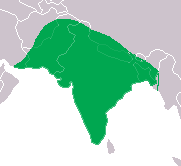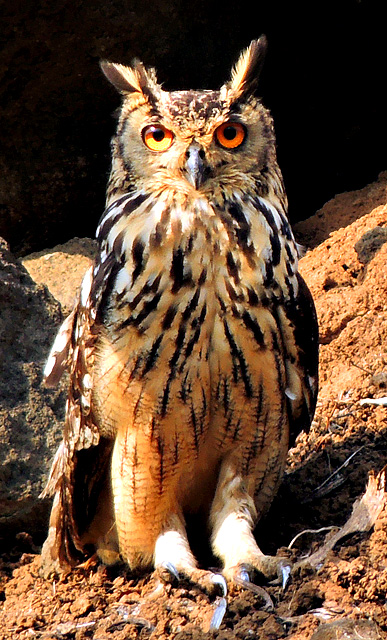Adult showing the black side edges to face mask.
Taxonomy
Otus bengalensis was the scientific name used by James Franklin in 1831 for an eagle-owl collected in northern India.[2]Description
Indian eagle-owl in a museum
The taxonomy of the group is complex due to a large amount of variation.[6] Dementiev was the first to consider the possibility of bengalensis being distinct within the Bubo bubo group. However Charles Vaurie noted that this as well as ascalaphus appeared to be distinct and not part of clinal variation. There is a lot of colour variation with the ground colour being dark brown above while some are pale and yellowish. On dark birds the streaks coalesce on the hind crown and nape but are narrow in pale birds. However, Vaurie notes that despite the variation, they are distinct from neighbouring forms B. b. tibetanus, B. b. hemachalana and B. b. nikolskii, in being smaller and richly coloured.[7][8] Stuart Baker noted that there were two plumage variants that were seen across their range, one plumage has the back and scapulars spotted in white while the other form has a reduced number of white spots on the feathers of the back and the dark streaking on the back, neck and scapulars being prominent.[9]
Chicks are born with white fluff which is gradually replaced by speckled feathers during the prejuvenile moult after about two weeks. After a month or so they go through a prebasic moult and a brownish juvenile plumage is assume with the upperparts somewhat like in adults but the underside is downy. The full adult plumage is assumed much later.[10]
Distribution
The underwing shows a dark carpal patch. The base of the primaries are unbarred.
Behaviour and ecology
Threat posture
Their diet through much of the year consists of rodents, but birds seem to be mainly taken towards winter. Prey species of birds include partridges, doves,[15] Indian roller,[16] the shikra and the spotted owlet. Birds the size of a peacock are sometimes attacked.[17] Rodents noted in a study in Pondicherry were Tatera indica, Golunda ellioti, Rattus sp., Mus booduga and Bandicota bengalensis. Bats were also preyed on.[18] In Pakistan, Nesokia indica is an important prey item in their diet.[19] Mammals the size of a Black-naped hare Lepus nigricollis may be taken.[20] In Pakistan, they have been found to take Lepus capensis and Eupetaurus cinereus.[21]
When feeding on rodents, they tear up the prey rather than swallow them whole.[22] Captives feed on about 61g of prey per day.[23]
The nesting season is November to April. The eggs number three to four and are creamy white, broad roundish ovals with a smooth texture. They are laid on bare soil in a natural recess in an earth bank, on the ledge of a cliff, or under the shelter of a bush on level ground.[15][16] The nest site is reused each year.[24] The eggs hatch after about 33 days and the chicks are dependent on their parents for nearly six months.[25]
In culture
This large owl with the distinctive face, large forward-facing eyes, horns and deep resonant call is associated with a number of superstitions. Like many other large owls, these are considered birds of ill omen. Their deep haunting calls if delivered from atop a house are considered to forebode the death of an occupant. A number of rituals involving the capture and killing of these birds have been recorded. Salim Ali notes a wide range of superstitions related to them but notes two as being particularly widespread. One is that if the bird is starved for a few days and beaten, it would speak like a human, predicting the future of the tormentor or bringing them wealth while the other involves the killing of the bird to find a lucky bone that moved against the current like a snake when dropped into a stream.[26] Belief in these superstitions has led to the persecution of the species in many areas by tribal hunters. The capture of these birds is illegal under Indian law but an underground market continues to drive poaching.[27]Regional names
Binomial name
Bubo bengalensis





No comments:
Post a Comment
Note: Only a member of this blog may post a comment.